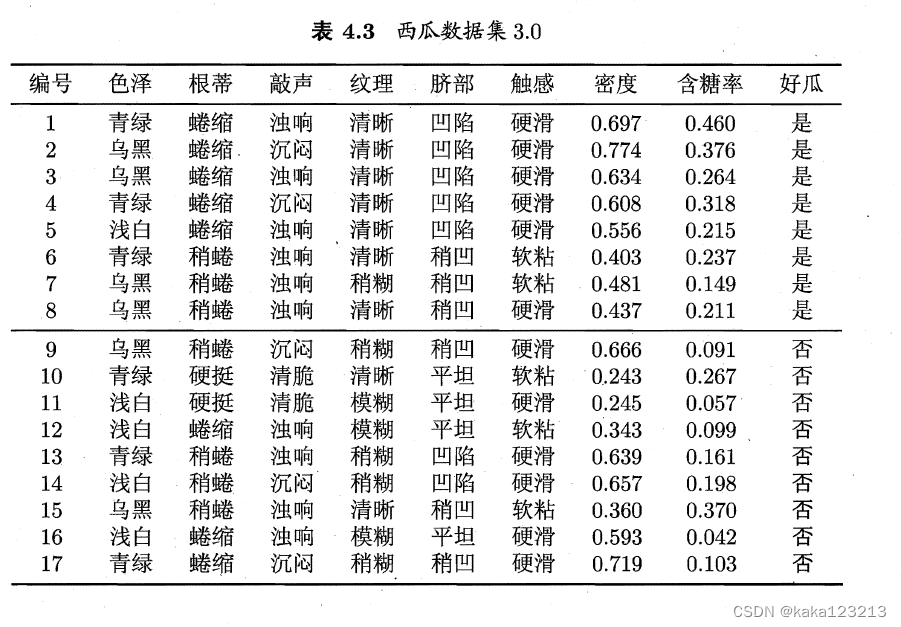一、发文起因:
1、为一起学习机器学习的同伴提供参考
2、求大佬看看处理思路有没有问题
二、程序亮点:
1、采用Numpy向量化进行计算,提高了计算速度
2、对连续型数据进行了针对性的处理
三、输入数据结构:
AODE类输入数据遵循以下结构:
1、数据集纵向排列,每一行是一组数据参数
2、标签应置于数据组的最后一列
3、以np.array([])格式进行输入shape=(a,d+1)a为数据量,d为参数个数
大家可根据此结构直接套用主代码。ps:使用前务必阅读注释
其余参数参照主代码和注释。
四、源码
(本人非计算机类、数学类专业,不足之处敬请指出)
import numpy as np
import matplotlib.pyplot as plt
import math
from scipy.stats import multivariate_normal
def load_data():#载入数据,此处载入数据的函数是搬运过来的与AOME_mode所要求的数据结构有出入,在主程序中对数据结构进行再处理
features = np.array([
[1, 2, 2, 1, 0, 1, 2, 2, 2, 1, 0, 0, 1, 0, 2, 0, 1],
[2, 2, 2, 2, 2, 1, 1, 1, 1, 0, 0, 2, 1, 1, 1, 2, 2],
[1, 0, 1, 0, 1, 1, 1, 1, 0, 2, 2, 1, 1, 0, 1, 1, 0],
[0, 0, 0, 0, 0, 0, 1, 0, 1, 0, 2, 2, 1, 1, 0, 2, 1],
[2, 2, 2, 2, 2, 1, 1, 1, 1, 0, 0, 0, 2, 2, 1, 0, 1],
[1, 1, 1, 1, 1, 0, 0, 1, 1, 0, 1, 0, 1, 1, 0, 1, 1],
[0.697, 0.774, 0.634, 0.608, 0.556, 0.403, 0.481, 0.437, 0.666, 0.243, 0.245, 0.343, 0.639, 0.657, 0.360, 0.593,
0.719],
[0.460, 0.376, 0.264, 0.318, 0.215, 0.237, 0.149, 0.211, 0.091, 0.267, 0.057, 0.099, 0.161, 0.198, 0.370, 0.042,
0.103]
])
labels = np.array([
[1, 1, 1, 1, 1, 1, 1, 1, 0, 0, 0, 0, 0, 0, 0, 0, 0]
])
features = features.T.astype(np.float64)
labels = labels.T.astype(np.float32)
return features, labels
def joint_pdf(x, y, u1, u2, sigma1, sigma2, p): # 联合正态分布
cov = [[sigma1 ** 2, p * sigma1 * sigma2], [p * sigma1 * sigma2, sigma2 ** 2]]
mvn = multivariate_normal([u1, u2], cov,allow_singular=True)
return mvn.pdf([x, y])
def normal_distribution_probability(sigma, x, u): # 正态分布
if sigma==0:
sigma=1e-12
return (1 / (sigma * np.sqrt(2 * np.pi))) * np.exp(-((x - u) ** 2) / (2 * (sigma ** 2)))
def calculate_correlation(x, y): # 计算相关系数
mean_x = np.mean(x)
mean_y = np.mean(y)
cov_xy = np.mean((x - mean_x) * (y - mean_y))
std_x = np.std(x)
std_y = np.std(y)
correlation = cov_xy / (std_x * std_y)
return correlation
def calculate_variance(x): # 计算标准差
variance = np.var(x) # 使用 numpy 库中的 var 函数来计算数组 x 的方差
return np.sqrt(variance)
def calculate_mean(x): # 计算均值
mean = np.mean(x) # 使用 numpy 库中的 mean 函数来计算数组 x 的均值
return mean
def ask_index(ask):#由输入生成索引矩阵
raw = np.arange(0, ask.shape[1], 1).reshape([1, ask.shape[1]])
raw = np.concatenate([raw] * ask.shape[0], axis=0)
raw1 = np.arange(0, ask.shape[0], 1).reshape([ask.shape[0], 1])
raw1 = np.concatenate([raw1] * ask.shape[1], axis=1)
ret = raw * 1000 + raw1#编码处
return ret
#生成的索引矩阵有些特殊
#如索引为[[(0,0),(0,1)],生成的矩阵为:[[0000,0001],[1000,1001]]相当于一个编码,后续再通过取整取余解码
# [(1,0),(1,1)]]
#注意当数据量很大时,应调高1000的数值,同时解码处的数值相应调高
class AODE_model:
def __init__(self, z_data, continuous_variable_index,m):#z_data为数据,continuous_variable_index为连续型数据的索引值,m为数据量阈值
self.z = z_data
self.cvi = continuous_variable_index
self.m=m
def data_extractor(self, ij_index_list, l_index, ask, c):#数据筛选器
if c=='False':
ret=np.array([i for i in self.z if all(i[j] == ask[l_index, j] for j in ij_index_list)])
return ret
ret = np.array([i for i in self.z if i[-1] == c and
(not ij_index_list or all(i[j] == ask[l_index, j] for j in ij_index_list))])
return ret
def category_quantity_query(self, index):#类型计数器
list = np.unique(self.z[:, index])
return len(list)
def prior(self, ask_indexd, ask, c):#P(c|x)计算,此处传入的ask_indexd是单个数值,是向量化传入的,其余直接传入
i_index = int(ask_indexd // 1000)#解码处
l_index = int(ask_indexd % 1000)
Di=self.data_extractor([i_index],l_index,ask,c='False')
if Di.shape[0]<self.m:
return 0
if i_index in self.cvi:
Dc = self.data_extractor([], l_index, ask, c)
sigma1 = calculate_variance(Dc[:, i_index])
u1 = calculate_mean(Dc[:, i_index])
use1 = normal_distribution_probability(sigma1, ask[l_index, i_index], u1)
use2 = (Dc.shape[0] + 1) / (self.z.shape[0] + self.category_quantity_query(-1))
ret=use1 * use2
return ret
Dci = self.data_extractor([i_index], l_index, ask=ask, c=c)
Ni = self.category_quantity_query(i_index)
ret=(Dci.shape[0] + 1) / (self.z.shape[0] + Ni)
return ret
vprior = np.vectorize(prior, excluded=['ask'])
def posterior(self, j_index, i_index, l_index, ask, c):#计算P(xj|c,xi)
if j_index in self.cvi and i_index in self.cvi:
data1 = self.data_extractor([], l_index, ask, c)
sigma1 = calculate_variance(data1[:, i_index])
sigma2 = calculate_variance(data1[:, j_index])
p = calculate_correlation(data1[:, i_index], data1[:, j_index])
u1 = calculate_mean(data1[:, i_index])
u2 = calculate_mean(data1[:, j_index])
use1 = joint_pdf(ask[l_index, i_index], ask[l_index, j_index], u1, u2, sigma1, sigma2, p)
use2 = normal_distribution_probability(sigma1, ask[l_index, i_index], u1)
return use2 / use1
if i_index in self.cvi:
Dcj = self.data_extractor([j_index], l_index, ask, c)
if Dcj.size==0:
return 0
sigma1 = calculate_variance(Dcj[:, i_index])
u1 = calculate_mean(Dcj[:, i_index])
use1 = normal_distribution_probability(sigma1, ask[l_index, i_index], u1)
Nj = self.category_quantity_query(j_index)
use2 = (Dcj.shape[0] + 1) / (self.z.shape[0] + Nj)
Dc = self.data_extractor([], l_index, ask, c)
sigma2 = calculate_variance(Dc[:, i_index])
u2 = calculate_mean(Dc[:, i_index])
use3 = normal_distribution_probability(sigma2, ask[l_index, i_index], u2)
use4 = (Dc.shape[0] + 1) / (self.z.shape[0] + self.category_quantity_query(-1))
return (use1 * use2) / (use3 * use4)
if j_index in self.cvi:
Dci = self.data_extractor([i_index], l_index, ask, c)
if Dci.size==0:
return 0
sigma1 = calculate_variance(Dci[:, j_index])
u1 = calculate_mean(Dci[:, j_index])
use1 = normal_distribution_probability(sigma1, ask[l_index, j_index], u1)
return use1
Dcij = self.data_extractor([i_index, j_index], l_index, ask, c)
Dci = self.data_extractor([i_index], l_index, ask, c)
Nj = self.category_quantity_query(j_index)
return (Dcij.shape[0] + 1) / (Dci.shape[0] + Nj)
vposterior = np.vectorize(posterior, excluded=['ask'])
def am_posterior(self, ask_indexd, ask, c):#计算累乘P(xj|c,xi)
i_index = ask_indexd // 1000#解码处
l_index = ask_indexd % 1000
j_index = np.arange(0, ask.shape[1], 1)
wait_to_mu = self.vposterior(self,j_index, i_index, l_index,ask=ask,c= c)
ret=np.cumprod(wait_to_mu)[-1]
return ret
vam_posterior = np.vectorize(am_posterior, excluded=['ask','c'])
def Judgment_function_by_c(self, ask, c):#计算P(c|x)
ask_indexd = ask_index(ask)
am = self.vam_posterior(self,ask_indexd=ask_indexd, ask=ask, c=c)
pri = self.vprior(self,ask_indexd=ask_indexd, ask=ask, c=c)
ret = np.multiply(am, pri)
return np.sum(ret, axis=1)
def pred(self, ask):#进行比较输出预测结果
n = np.unique(self.z[:, -1])
jude = np.array([])
for c in n:
judement = self.Judgment_function_by_c(ask, c)
if jude.size==0:
jude=np.expand_dims(judement,axis=1)
else:
jude=np.concatenate((jude,np.expand_dims(judement,axis=1)),axis=1)
result=np.array([])
for i in jude:
result=np.append(result,n[np.argmax(i)])
return np.expand_dims(result,axis=1)
if __name__ == '__main__':
x, y = load_data()
z = np.concatenate((x, y), axis=1)
ask = x.astype(np.float32)
mode = AODE_model(z, [6, 7],5)
result=mode.pred(ask)
print(result)五、离散型数据处理思路:
此代码对于离散型数据的处理,采用了正态分布函数进行处理:

附录:
一、数据集(来自西瓜书):

二、计算公式






















 1180
1180

 被折叠的 条评论
为什么被折叠?
被折叠的 条评论
为什么被折叠?








